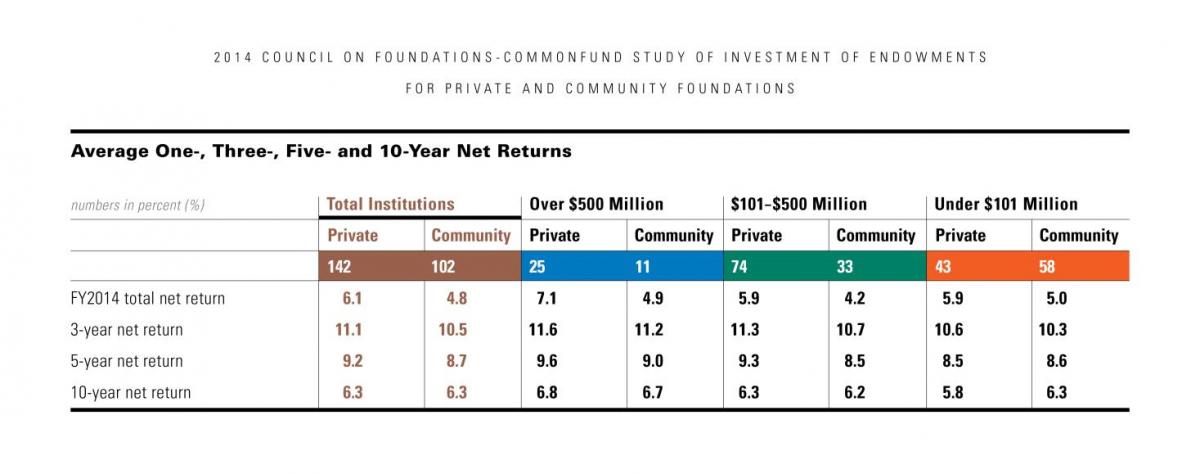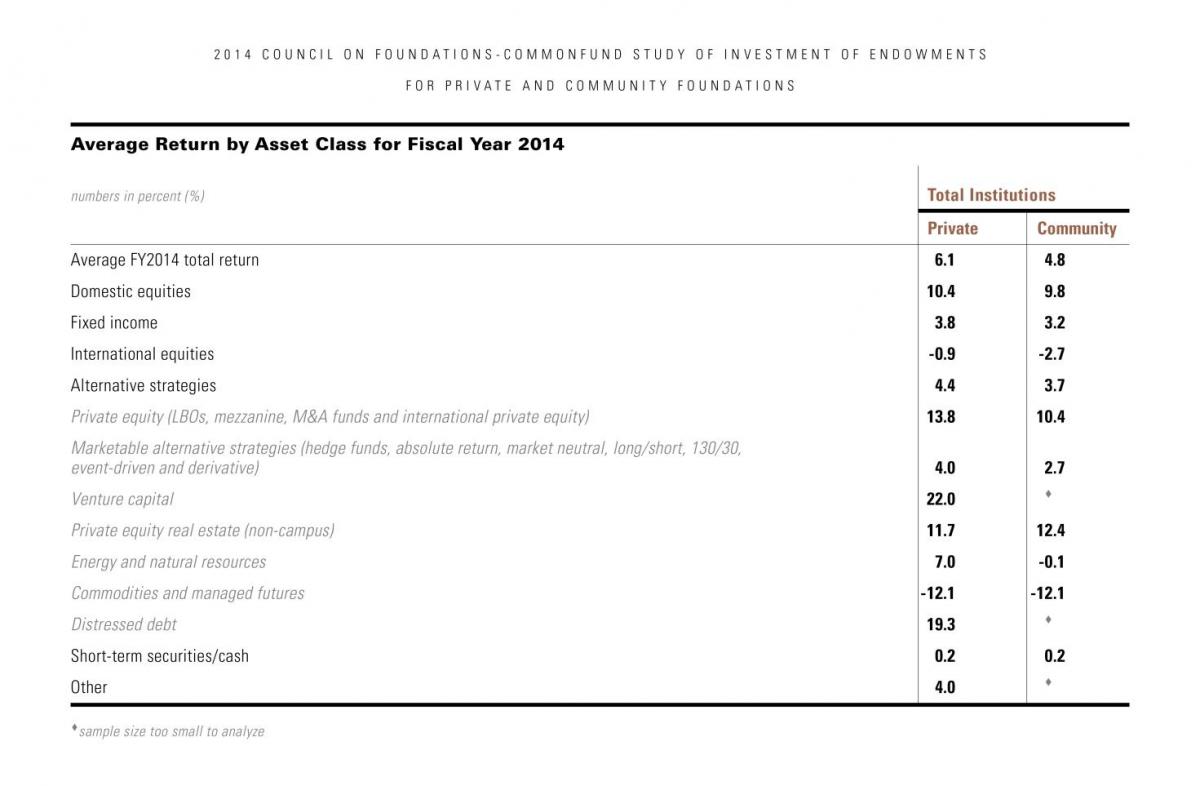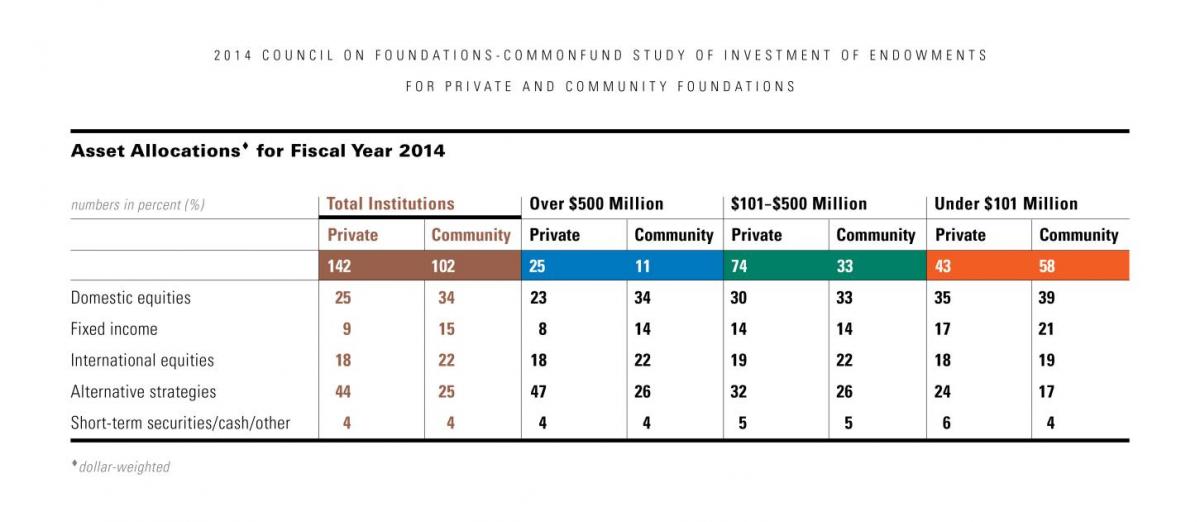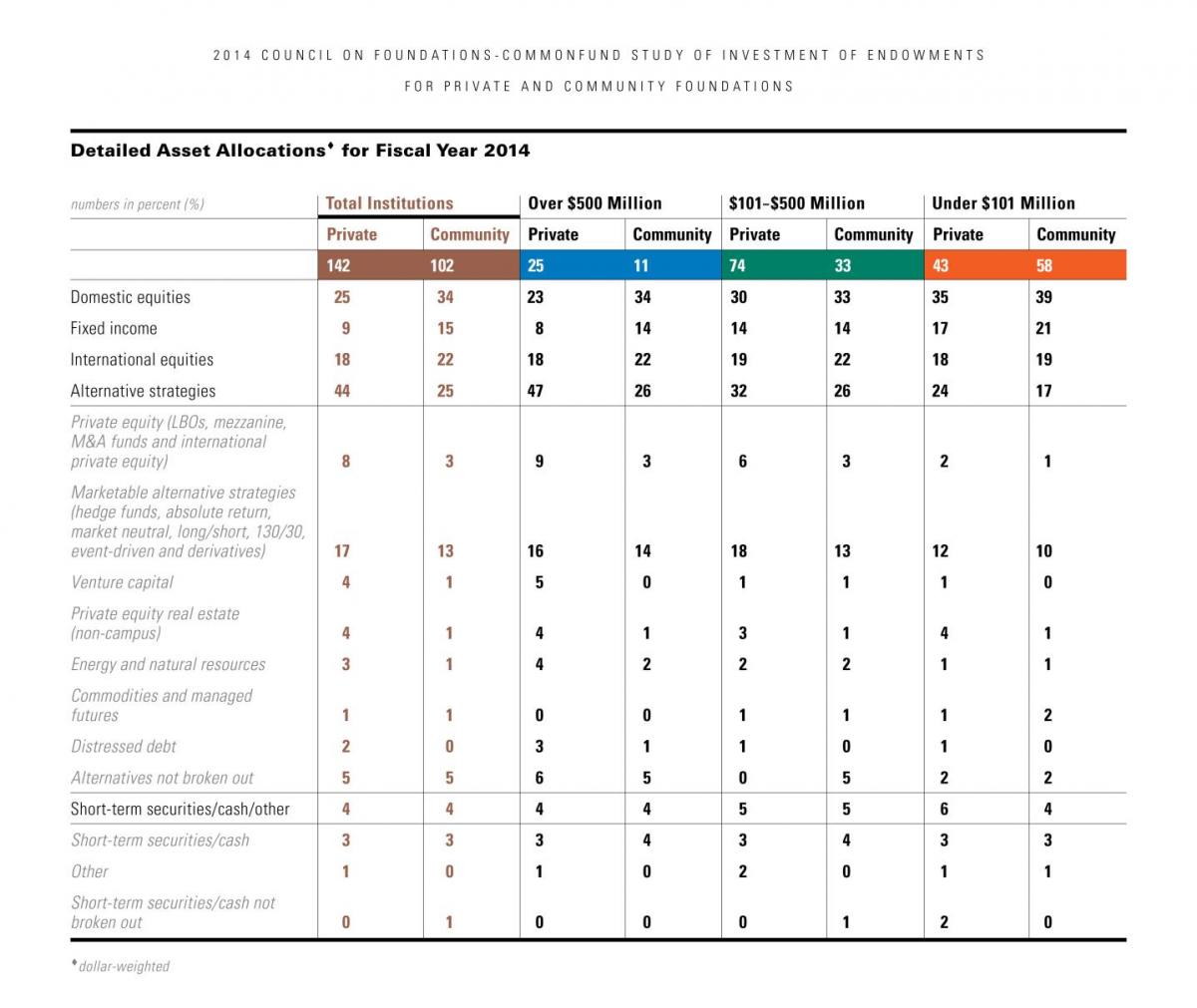Council on Foundations-Commonfund Study Reports Lower Foundation Returns Compared with Previous Year, While Mission-Related Spending Remains Steady
Private Foundations Report Average Net Investment Returns of 6.1 Percent for FY2014; Community Foundation Returns Are 4.8 Percent
Data gathered from 244 private and community foundations participating in the 2014 Council on Foundations–Commonfund Study of Investment of Endowments for Private and Community FoundationsTM (CCSF) show that the 142 private foundations participating in the study reported an average return of 6.1 percent for the 2014 fiscal year (January 1 – December 31, 2014), down from the 15.6 percent return reported for FY2013, while the 102 participating community foundations reported an average return of 4.8 percent for FY2014 compared to last year’s average return of 15.2 percent. (All return data are net of fees.)
The lower overall return figures reflect a decline in year-over-year investment returns from domestic and international equity-based investments and some alternative strategies. Only fixed income produced notably higher returns in FY2014:
|
Private Foundations |
Community Foundations |
|||
|
FY2014 |
FY2013 |
FY2014 |
FY2013 |
|
|
Domestic equities |
10.4% |
31.8% |
9.8% |
30.9% |
|
Fixed income |
3.8 |
-0.7 |
3.2 |
-0.7 |
|
International equities |
-0.9 |
15.9 |
-2.7 |
15.1 |
|
Alternative strategies |
4.4 |
7.3 |
3.7 |
10.2 |
|
Short-term securities/ |
0.2 |
0.1 |
0.2 |
1.9 |
The 2014 CCSF is the third annual report produced jointly by the Council on Foundations and Commonfund Institute. With 244 participating foundations representing combined assets of $107.4 billion, we believe the CCSF is the most comprehensive annual survey of its kind by two preeminent authorities on foundation investment and governance policies and practices. This year, the addition of data on community foundation investments provides additional benchmarking information on foundation operations.
The Study segments participating private foundations and community foundations into:
- those with endowment assets over $500 million;
- those with assets between $101 and $500 million; and
- those with assets under $101 million.
When 2014 CCSF return data are analyzed by size and type of participating foundation, private foundations produced the higher returns across all size categories. Among the largest foundations, private foundations generated a return of 7.1 percent for FY2014. Community foundations of the same size produced an average return of 4.9 percent. Among foundations with assets between $101 and $500 million, private foundations returned an average of 5.9 percent, and community foundations of this size returned 4.2 percent. Among those with assets under $101 million, private foundations returned an average of 5.9 percent, and community foundations returned an average of 5.0 percent.
A similar pattern held for longer time periods. Participating private foundations returned an average of 11.1 percent for the trailing three-year period, while community foundations returned 10.5 percent. For the trailing five-year period, private foundations returned an average of 9.2 percent, and community foundations gained 8.7 percent. An exception occurred in the trailing 10-year period, during which both types reported an average annual return of 6.3 percent.

Informing Foundation Decision-Making
In a joint statement, Vikki Spruill, President and CEO of the Council on Foundations, and John S. Griswold, Executive Director of Commonfund Institute, said, “This research shows that foundation leaders continued to invest in communities through steady mission-related grantmaking, even though their FY2014 returns were affected by subdued global equity markets.”
Spruill and Griswold noted that the great majority of participating institutions – 59 percent of private foundations and 61 percent of community foundations – reported increasing their grantmaking or mission-related spending in dollar terms in FY2014. Among private foundations, the average rate of increase was 21.1 percent, while among community foundations the average increase was 33.9 percent.
“The data also provide important context for the financial story of foundations following the severe downturn of FY2008, when asset values declined in the range of 25 percent,” said Griswold. “The declines of that time have held down the trailing 10-year average return at just 6.3 percent, despite double-digit gains in more recent years.”
“This research also helps us understand how the economic recovery has impacted foundation decision-making,” added Spruill. “Recent investment gains were sufficient to fund foundations’ mission-related grantmaking, while also keeping pace with inflation and the cost of managing investment programs.”
Griswold and Spruill continued, “This research provides foundation leaders benchmarking to understand their own financial performance, and it will help them make more informed decisions about both their investment and grantmaking strategies.”
The average annual effective spending rate for FY2014 was 5.4 percent among private foundations, a modest decrease compared with last year’s 5.5 percent and reflective of the rapidly rising markets of recent years. The average annual effective spending rate among community foundations was unchanged at 4.8 percent.
Spruill and Griswold commented, “While grantmaking levels are only one indication of the vital role performed in our society by the philanthropic sector, it is clear that foundations are maintaining or increasing their grantmaking dollars to support essential services at a time when public spending is under pressure.”
Detailed Return Data
As in FY2013, domestic equities produced the highest return in FY2014, at 10.4 percent for private foundations and 9.8 percent for community foundations. Alternative strategies followed, generating a 4.4 percent return for private foundations and 3.7 percent for community foundations. Fixed income returns averaged 3.8 percent for private foundations and 3.2 percent for community foundations. Short-term securities/cash/other followed, generating an equal return of 0.2 percent for both private foundations and community foundations. International equity returns were negative for the fiscal year, returning -0.9 percent for private foundations, while community foundations’ international equity returns averaged -2.7 percent.

Within the broad category of alternative strategies, venture capital produced the highest return for private foundations, at 22.0 percent.* Distressed debt, which produced the highest return among alternative strategies for the past two years, was still strong, generating a 19.3 percent return for private foundations.* Private equity real estate returned 11.7 percent among private foundations and for community foundations it returned 12.4 percent.
Private equity (LBOs, mezzanine funds, M&A funds and international private equity) returned 13.8 percent for private foundations and 10.4 percent for community foundations. Respectively for these two types of foundation, energy and natural resources returned 7.0 percent and -0.1 percent.
Marketable alternative strategies (hedge funds, absolute return, market neutral, long/short, 130/30, event-driven and derivatives), returned 4.0 percent for private foundations and 2.7 percent for community foundations. Commodities and managed futures produced a negative return of -12.1 percent for both types of foundation.
* The number of responses for this investment strategy among community foundations was too small to analyze.
Asset Allocation
At December 31, 2014, participating institutions’ asset allocations—and comparable FY2013 allocations—were:
|
Private Foundations |
Community Foundations |
|||
|
FY2014 |
FY2013 |
FY2014 |
FY2013 |
|
|
Domestic equities |
25% |
24% |
34% |
28% |
|
Fixed income |
9 |
9 |
15 |
13 |
|
International equities |
18 |
20 |
22 |
23 |
|
Alternative strategies |
44 |
42 |
25 |
27 |
|
Short-term securities/ |
4 |
5 |
4 |
9 |


Research Process and Methodology
The design of the 2014 Council on Foundations–Commonfund Study of Investment of Endowments for Private and Community Foundations (CCSF) took place in the winter of 2014. Field interviews with the participating institutions followed in the first and second calendar quarters of 2015.
Online interviews were supported by extensive telephone contact, a research technique that assures greater integrity in the data gathering process. Respondents were the individuals most knowledgeable about investment matters at participating institutions.
Data from the Study’s research population were segmented by private foundations and community foundations to permit analysis of the policies and practices of these two differing foundation types. Data were also segmented into three size categories to compare and contrast the policies and practices of foundations of differing sizes. As noted, the size categories were: institutions with assets over $500 million; institutions with assets between $101 million and $500 million; and institutions with assets under $101 million.
The third annual CCSF will be made available to all participants. The report will also include a comprehensive written analysis setting the data in the context of the current financial environment and recent trends.
NOTE: For purposes of this Report, information and data have been included for community foundation endowment funds only. The results of the research do not reflect the activity of the many different types of funds that community foundations hold that are non-endowed designated, field of interest, agency, scholarship and donor-advised funds, temporary project funds and pass-through funds.
###
About The Council on Foundations
An active philanthropic network, the Council on Foundations (www.cof.org), founded in 1949, is a nonprofit leadership association of grantmaking foundations and corporations. It provides the opportunity, leadership, and tools needed by philanthropic organizations to expand, enhance, and sustain their ability to advance the common good. With members from all foundation types and sizes, the Council empowers professionals in philanthropy to meet today’s toughest challenges and advances a culture of charitable giving in the U.S. and globally.
About Commonfund
Commonfund was founded in 1971 as an independent asset management firm focused on not-for-profit institutions. Today, we are one of North America’s leading investment firms, managing $25 billion in assets for some 1,300 institutional clients, including educational endowments, foundations and philanthropic organizations, hospitals and healthcare organizations and pension plans. Our only business is investment management, and we are active in all sectors of the global capital markets, both public and private.
About Commonfund Institute
Commonfund Institute houses the education and research activities of Commonfund and provides the entire community of long-term investors with investment information and professional development programs. Commonfund Institute is dedicated to the advancement of investment knowledge and the promotion of best practices in financial management. In addition to teaming with the Council on Foundations to produce the CCSF, Commonfund also produces the NACUBO-Commonfund Study of Endowments (NCSE) and the Commonfund Benchmarks Study series of research reports. Commonfund Institute also provides a wide variety of resources, including conferences, seminars and roundtables on topics such as endowments and treasury management; proprietary and third-party research and publications, including the Higher Education Price Index (HEPI) and Insight Online, a biannual investment magazine; and events such as the annual Commonfund Forum and Commonfund Endowment Institute.


